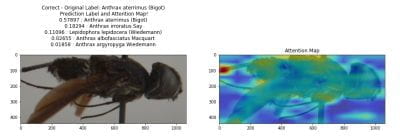Pierce Helton is an Honors student studying Computer Science. This summer, he worked as a research assistant in the department’s Computer Vision and Image Understanding Lab. Here, he had an opportunity to broaden his understanding of machine learning and contribute to department research. Pierce plans to work in the industry and potentially pursue a M.S. in Computer Science after earning his B.S.
During the Summer of 2022, I worked in the Computer Vision and Image Understanding lab of the Computer Science and Computer Engineering Department. My project dealt with measuring the presence of insects in nature. Since insects and the tools used to manage them have a massive impact on crop management, public policy and the economy as a whole, our lab wanted to create an artificial intelligence (AI) system to classify and provide a real-time count of insects to aid in the decision-making process. To develop a system capable of performing these tasks, I worked on training AI models in classification and identification, as well as fine tuning them for deployment.
I first joined the lab during the Summer of 2021. At first, I focused on data collection for the insect project and learning AI basics. Starting with the insect project allowed me to learn the most about the field while still being able to contribute to research. As my skills developed and my understanding of machine learning broadened, I began to perform more complex tasks like training AI and modifying existing projects. My research was submitted and published by the University of Arkansas Inquiry Journal, too. During Spring of 2022 Khoa Luu, professor of Computer Science and my research mentor, suggested that I apply for the research grant. I was enjoying the research and saw it as a valuable opportunity to learn more about the field, so I decided to apply.
One of the goals of this project was the development of a prototype system that could detect and identify insects. I had already completed the training of the detection model prior to receiving the grant. However, I still needed to train the classification model and deploy the two models onto our prototype hardware system. Training the classification model first required the creation of a dataset of detected insects produced by our detection model. This is because detection precedes classification in our bug system: an insect needs to be detected before it can be classified.

The classification output of an AI model I was working on for a bee fly. Here, the model is determining what kind of fly has been detected.
To train the model, we passed images from our custom bug dataset to the detection model. Any incorrect or inaccurate samples were removed from the set of images. Images were then given a label according to their species and used to train a Vision Transformer to perform identification. After training, our model correctly identified the species of an insect 95% of the time. Although we were working with a family of insects, the Bombyliidae family, the results were a promising next step in the production of our functioning prototype and AI system. Once the classification model was complete, an additional program was created to allow images from our prototype to be detected and classified in real time.
Moving forward, we’d like to perform more field tests, fix any issues found, and increase the number of insects that the model can recognize. After this, a production model can be developed to begin the deployment stage of the project. Additionally, we’d like to publish our research to AI and machine learning conferences such as Nature Machine Intelligence. Currently, these submissions are in development.
The project has taught me much regarding software development and AI. I also learned more about how to work with machine learning models. Understanding the flow of information and the data types used are some of the more important AI concepts, so getting more exposure to these ideas and skills was a valuable experience. In any field, encountering a problem can significantly slow progress, but working with a team and asking for help is crucial; sometimes another point of view is all you need.
Most of the challenges I dealt with included errors in code, and my other lab members were always willing to help. Dr. Luu has been a great research mentor, too. He guides our lab, helping us with research and developing projects. He works with us to create AI solutions for various real-world problems in any number of fields. I look forward to continuing working with Dr. Luu and the lab on this project in the future. Overall, having the opportunity to do practical work that I enjoy while helping others has been an exciting and rewarding experience.

